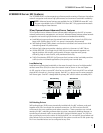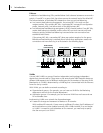
1 Introduction
10
Failover
In addition to load balancing, RSLs provide failover fault tolerance between a server and a
switch—if one NIC in a group fails, the others assume the network load of the failed NIC.
The failover behavior of secondary NICs depends on how you set load balancing:
■ In a transmit load balancing arrangement, the primary NIC is the only one that
receives packets. If the primary NIC fails, a secondary NIC assumes the configuration
profile, network traffic, and active status of the failed primary NIC.
■ In a bidirectional load balancing arrangement, all NICs receive packets. If any NIC fails,
receive load balancing is disabled, and the other NICs continue transmit-only load
balancing activity. Receive load balancing is restored when new connections are
established with clients.
If the primary NIC fails, a secondary NIC takes over packet reception for the group.
Bidirectional load balancing is restored after a failure when applications create new
connections and new clients log in as illustrated in the following figure.
VLANs
A virtual LAN (VLAN) is a group of location-independent and topology-independent
devices that communicate as if they were on the same physical LAN. Network devices on
different LAN segments and of different media types can be members of the same VLAN.
Membership in a VLAN is determined by a VLAN tag that is transmitted with the Ethernet
frame for use by a switch.
With VLANs, you can define a network according to:
■ Organizational groups—For example, you can have one VLAN for the Marketing
department and one for the Finance department.
■ Application groups—For example, you can have one VLAN for e-mail users and one
for multimedia users.
Implementing VLANs on a network has these advantages:
■ It eases the change and movement of devices on IP networks.
With traditional IP networks, if users move to a different IP subnet, the IP addresses of
each workstation must be updated manually. With VLANs installed, if an end station
on VLAN 1 is moved to a port elsewhere on the network, you need only to specify
that the new port is on VLAN 1.
® ® ®
Server
Bidirectional
load balancing
Primary failure Secondary failure
Clients
Primary
Secondaries
Primary
Secondaries
Primary
Secondaries
Switch
®


















